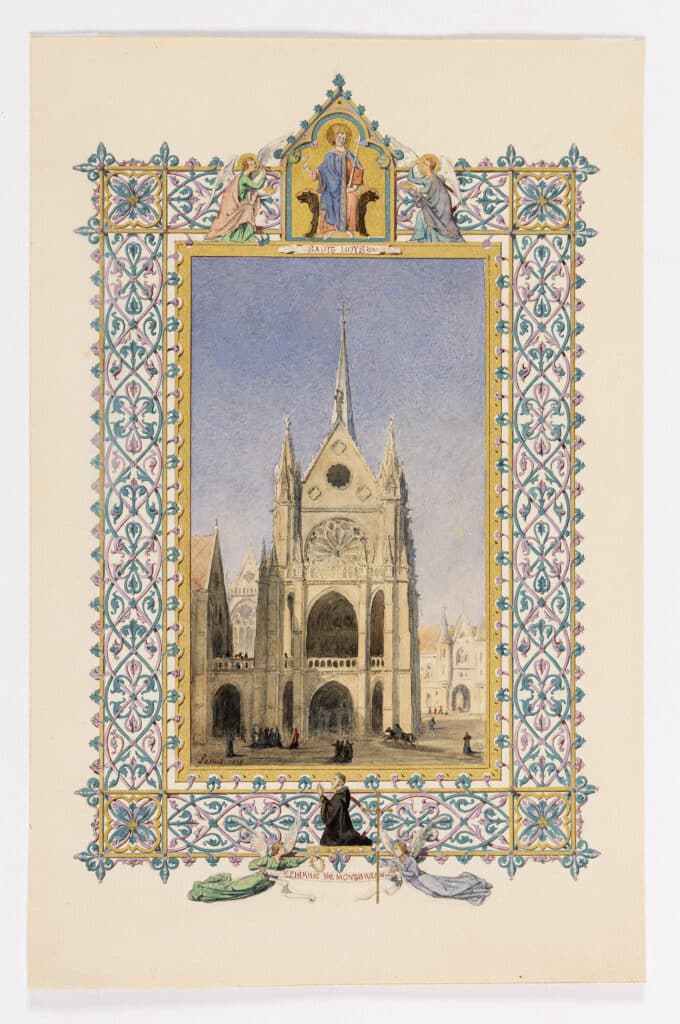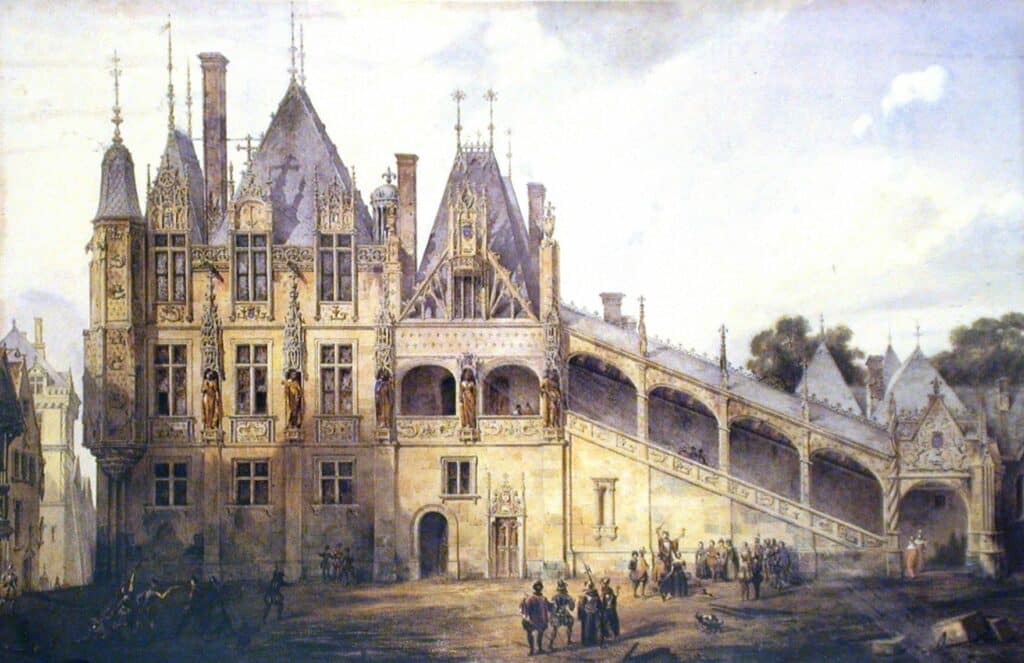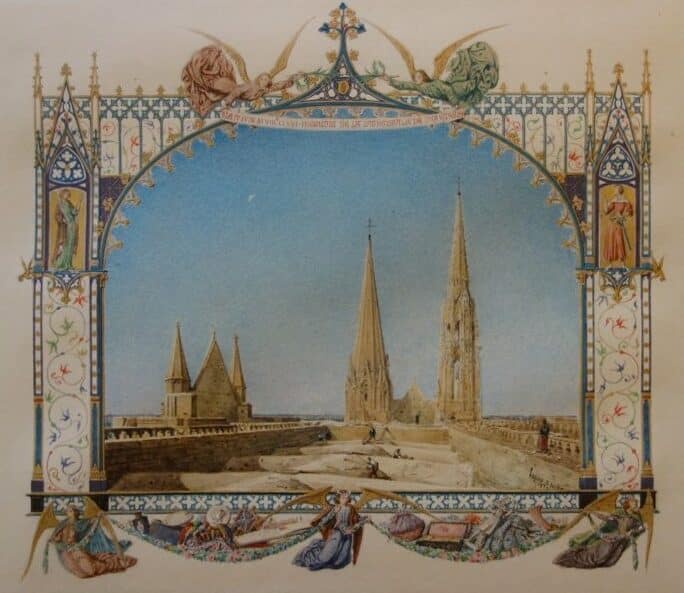Jean-Baptiste Lassus
After a brief passage at the École des Beaux-Arts in Paris in the studio of Henri Labrouste from 1828 to 1830, French architect Jean-Baptiste Lassus fell under the sway of the romantic cult of history and turned toward the middle ages. Together with his life-time associate Eugène-Emmanuel Viollet-le-Duc (1814–1879), he became one of the main actors within the July Monarchy’s campaign at preserving French medieval monuments, with Notre-Dame and the Sainte-Chapelle in Paris as his most accomplished restorations. The latter building attracted Lassus’s interest very early. He exhibited a set of drawings at the Parisian salon in 1835, meticulously restituting Saint-Louis’s chapel to its original form. The work caused quite a stir in artistic circles and brought him a level of notoriety, including a gold medal at the salon. It was the first systematic study for a restoration project of a Gothic monument ever developed in France. The romantic journal L’artiste celebrated the work as having the capacity to ‘evoke great historical memories’ and even to play a role in the conception of modern public monuments. [1]

The fairy-like Sainte-Chapelle was indeed the perfect vehicle to generate a phantasmagoria of the past. Victor Hugo himself had singled out the building as the most popular medieval building in Paris, and the Journal des débats militated for its restoration, which was indeed launched under the direction of the architect Félix Duban in late 1836. [2] Thanks to the success of his 1835 restoration project, Lassus was hired as Premier inspecteur on the restoration site, his special knowledge of Gothic, and of this building in particular, conferring upon him unusual authority with Duban. Viollet-le-Duc would soon join the restoration team in late 1840, together with the architects Louis Sureda and Émile Boeswillwald. The Sainte-Chapelle thus became the site where the neo-Gothic clan crystallised in France. In July 1849, Lassus would take over from Duban as chief architect, a post he kept until his early death on 15 July 1857.
The watercolour of the Sainte-Chapelle drawn by Lassus dates from the first years of the restoration, when the desire to restore the monument to its original thirteenth-century form was still very strong. The chapel is shown without its fifteenth-century flamboyant rose window and its exterior staircase built by Louis XII, taking the more sober appearance it may have had during the reign of Saint-Louis. Lassus clearly emphasises that intention by inscribing at the top ‘Saint Loys’, and at the bottom the name of the original architect, ‘Pierre de Montereau’.
The perspective view also gives us a glimpse of the larger medieval context surrounding the Sainte-Chapelle. On the north side (at the left of the drawing), we see the first bay of the gallery leading to the Palais de la Cité’s famous double-nave grand’ salle, and in the background, the gable and small rose of the chapel’s annex, the trésor des chartres. Behind the Sainte-Chapelle on the right, Lassus draws a view of the east side of the Palais’ enclave, showing the original gate that lead to the rue de la Barillerie (now the Boulevard du Palais). These details show how much care Lassus spent restituting the medieval site. He is indeed known as one of the very first architects to have understood the value of collecting historical documents, written and visual, to plan restoration work.

Aside from these archaeological details, however, the most interesting aspect of the watercolour is its attempt to give a fictional view of the Sainte-Chapelle in its original time. Not only is the architecture restituted to its original thirteenth-century appearance, but an historical scene is taking place before our eyes, as if we were able to visually penetrate the enclave of the Palais de la Cité on a typical day of the thirteenth century. It is difficult to specify what Lassus was trying to portray exactly, but the gathering of people in small groups and the historical dresses leave no doubt as to his desire to stage a historical narrative. Standing on the boundary between history and fiction, the representation clearly betrays the sort of mythic curiosity that led romantic historians and painters to strive for a ‘true’ historical representation that could fire the imagination of the viewer. He shared this disposition with Viollet-le-Duc, who, at the salon of 1836, had exhibited a restored perspective view of the old Chambre des Comptes (which originally stood next to the Sainte-Chapelle in the court of the Palais), as it may have appeared during the St. Bartholomew’s Day Massacre in 1572 (fig. 1). Both Lassus and Viollet-le-Duc were overtaken by the fantasy of not only restoring but also reliving the past.

Finally, we must bring attention to the gilded border that surrounds Lassus’s drawing. Inspired directly by medieval illuminations, it further underscores Lassus’s desire to produce a representation impregnated with the spirit of the middle ages. He had produced that type of decorated border earlier for a drawing of a view of the roof of Chartres cathedral after the fire of 4 June 1836 (fig. 2). [3] The elaborate character of the illumination points to the possibility that the drawing was meant to be part of a bound album. [4] But no conclusion can be reached on this regard, especially as the rather sketchy character of the watercolour itself seems to indicate a less formal purpose.
Notes
1. Unsigned, ‘Beaux-Arts, Salon de 1835. Architecture,’ L’artiste, vol. 9, 1835, p. 148.
2. Jean-Michel Leniaud, Jean-Baptiste Lassus (1807–1857) ou le temps retrouvé des cathédrales, Paris: Arts et Métiers Graphiques, 1980, p. 60.
3. See Alice Thomine, ‘From Yale to Paris — La collection de dessins d’architecture de Neil Levine’, Revue du Louvre, no. 5, 2014, pp. 12-14.
4. Niall Hobhouse suggests that the decoration, scale and manner of the drawing are very much in line with those of the famous 1837 compendium of watercolours known as ‘Vues de quelques Monuments de Paris achevés sous le règne de Louis Philippe 1er’ for which it may have been intended.
